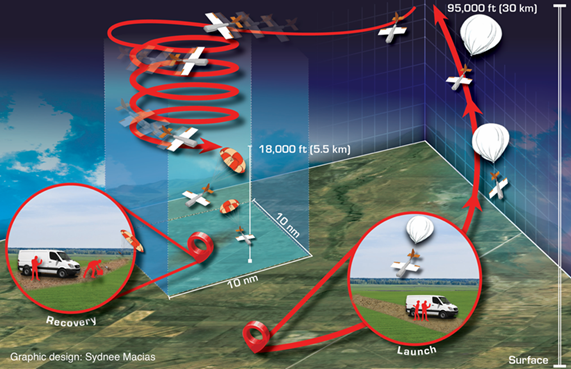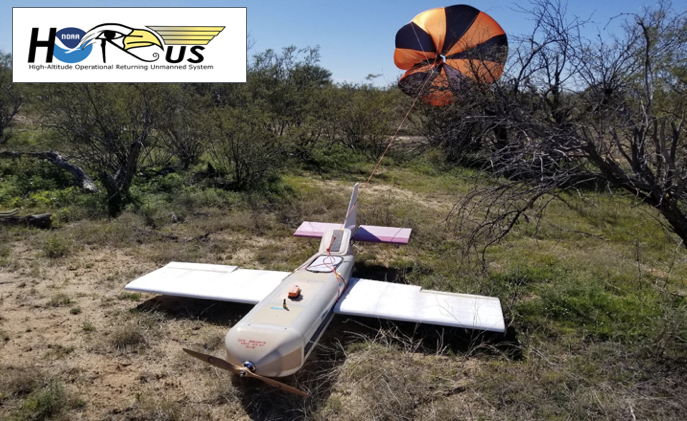NOAA’s Global Monitoring Laboratory Testing High-Altitude Operational Returning Unmanned System at NASA’s Armstrong Flight Research Center and Edwards Air Force Base
May 24, 2021

Global Monitoring Laboratory (GML) and Cooperative Institute for Research in Environmental Sciences (CIRES) scientists are launching a new AirCore field campaign to test a new method for high-altitude air sampling and instrument recovery. The goal of the current field campaign is to test the High-altitude Operational Returning Unmanned System (HORUS), a 6-foot wingspan, portable, fixed-wing glider for returning the AirCore and scientific instruments from the stratosphere.
The campaign will run from May 13-28, 2021 at the NASA Armstrong Flight Research Center and Edwards Air Force Base, California.
Similar to an ice core, the AirCore atmospheric sampling system collects a “core” of air vertically through the atmosphere. High-altitude balloons carry the device to the upper atmosphere (approximately 100,000 ft mean sea level [MSL]), where the balloon will release the instrument. The AirCore device starts to collect air during a parachute-based descent.
Unlike typical weather balloon payloads that are designed for one-time use, the AirCore is immediately recovered upon landing for laboratory analysis of the air sample. GML and CIRES staff measure and analyze the collected air “core” to obtain a vertical profile of gas measurements at different altitudes.
Since 2010, GML has launched and collected more than 160 AirCores, measuring greenhouse gases including carbon dioxide, methane, carbon monoxide, and recently nitrous oxide. AirCore gives scientists an enhanced understanding of the vertical distribution of these greenhouse gases in the atmosphere.
In this test of the HORUS, balloons are used to carry the scientific instruments up to 10,000 ft MSL where the balloon is released. During its descent, the HORUS glider autopilots the instrumentation to a predetermined landing site via an onboard computer. At 1,000 ft MSL, a parachute deploys, slowing the device and scientific instrumentation and enabling a soft landing.

Prior to HORUS, balloons with either parachutes or aircraft were used to sample the upper atmosphere—but parachutes cannot control the descent and landing locations of the balloon-borne instruments. If the equipment lands in inaccessible locations, challenges in retrieving the device could delay the laboratory analysis. So, routine AirCore sampling is limited to locations with open lands, such as those in eastern Colorado. Also, although aircraft can provide similar greenhouse gas observations, it is often too expensive for frequent sampling, especially for aircraft reaching similar altitudes as the AirCore.
Compared to aircraft and parachutes, HORUS allows for a portable, low-cost, flexible platform for sampling the atmosphere from high altitudes to the Earth’s surface. GML and CIRES scientists and collaborators previously tested the glider at low altitudes and are testing the glider in the stratosphere during the 2021 campaign.
If this field campaign is successful, HORUS will prove that the glider is capable of safely returning the scientific instruments from the stratosphere (above 50,000 ft MSL) to a location close to its initial launch site. This application of this glider technology could lead to high-altitude air sampling with atmospheric instrumentation in many locations worldwide, including remote areas experiencing rapid climate change.
